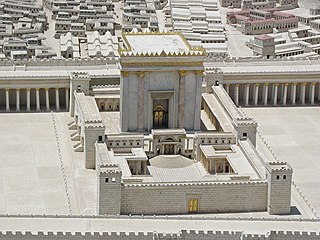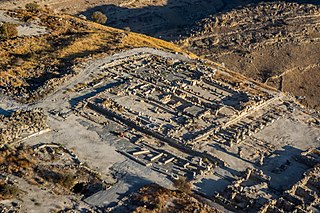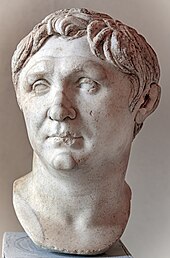
Herod I or Herod the Great was a Roman Jewish client king of the Herodian Kingdom of Judea. He is known for his colossal building projects throughout Judea. Among these works are the rebuilding of the Second Temple in Jerusalem and the expansion of its base—the Western Wall being part of it. Vital details of his life are recorded in the works of the 1st century CE Roman–Jewish historian Josephus.

The Second Temple, later known as Herod's Temple, was the reconstructed Temple in Jerusalem between c. 516 BCE and 70 CE. Defining the Second Temple period, it stood as a pivotal symbol of Jewish identity and was central to Second Temple Judaism; it was the chief place of worship, ritual sacrifice (korban), and communal gathering for Jews. As such, it attracted Jewish pilgrims from distant lands during the Three Pilgrimage Festivals: Passover, Shavuot, and Sukkot.

The Decapolis was a group of ten Hellenistic cities on the eastern frontier of the Roman Empire in the Southern Levant in the first centuries BC and AD. They formed a group because of their language, culture, religion, location, and political status, with each functioning as an autonomous city-state dependent on Rome. They are sometimes described as a league of cities, although some scholars believe that they were never formally organized as a political unit.

The Hasmonean dynasty was a ruling dynasty of Judea and surrounding regions during the Hellenistic times of the Second Temple period, from c. 140 BCE to 37 BCE. Between c. 140 and c. 116 BCE the dynasty ruled Judea semi-autonomously in the Seleucid Empire, and from roughly 110 BCE, with the empire disintegrating, Judea gained further autonomy and expanded into the neighboring regions of Perea, Samaria, Idumea, Galilee, and Iturea. The Hasmonean rulers took the Greek title basileus ("king") as the kingdom became a regional power for several decades. Forces of the Roman Republic intervened in the Hasmonean Civil War in 63 BCE and made it into a client state, marking the decline of Hasmonean dynasty; Herod the Great displaced the last reigning Hasmonean client-ruler in 37 BCE.
Siege of Jerusalem, fall of Jerusalem, or sack of Jerusalem may refer to:

Hippos or Sussita is an ancient city and archaeological site located on a hill 2 km east of the Sea of Galilee, attached by a topographical saddle to the western slopes of the Golan Heights.

Pella was an ancient city in what is now northwest Jordan, and contains ruins from the Neolithic, Chalcolithic, Bronze Age, Iron Age, Canaanite, Hellenistic and Islamic periods. It is located near a rich water source within the eastern foothills of the Jordan Valley, close to the modern village of Ṭabaqat Faḥl some 27 km (17 mi) south of the Sea of Galilee. The site is situated 130 km (81 mi) north of Amman: a drive of about two hours, and an hour southwest by car from Irbid, in the north of the country. Pella's ruins – predominantly temples, churches, and housing – have been partially excavated by teams of archaeologists; they attract thousands of tourists annually but especially in spring, during which time the area is awash with spring flowers.

Judaea was a Roman province from 6 to 132 CE, which incorporated the Levantine regions of Judea, Samaria and Idumea, extending over parts of the former regions of the Hasmonean and Herodian kingdoms of Judea. The name Judaea was derived from the Iron Age Kingdom of Judah.

Perea or Peraea was the term used mainly during the early Roman period for part of ancient Transjordan. It lay broadly east of Judea and Samaria, which were situated on the western side of the Jordan River, and southwest of the Decapolis.
The Ancient Macedonian calendar is a lunisolar calendar that was in use in ancient Macedon in the 1st millennium BCE. It consisted of 12 synodic lunar months, which needed intercalary months to stay in step with the seasons. By the time the calendar was being used across the Hellenistic world, seven total embolimoi were being added in each 19 year Metonic cycle. The names of the ancient Macedonian Calendar remained in use in Syria even into the Christian era.
Aryeh Kasher was an Israeli academic and writer. He was a professor at Tel Aviv University and winner of the 1990 Bialik Prize for Hebrew literature.
Hellenistic Judaism was a form of Judaism in classical antiquity that combined Jewish religious tradition with elements of Hellenistic culture. Until the early Muslim conquests of the eastern Mediterranean, the main centers of Hellenistic Judaism were Alexandria in Egypt and Antioch in Syria, the two main Greek urban settlements of the Middle East and North Africa, both founded in the end of the fourth century BCE in the wake of the conquests of Alexander the Great. Hellenistic Judaism also existed in Jerusalem during the Second Temple Period, where there was a conflict between Hellenizers and traditionalists.

The Second Temple period or post-exilic period in Jewish history denotes the approximately 600 years during which the Second Temple stood in the city of Jerusalem. It began with the return to Zion and subsequent reconstruction of the Temple in Jerusalem, and ended with the First Jewish–Roman War and the Roman siege of Jerusalem.

Judea or Judaea is a mountainous region of the Levant. Traditionally dominated by the city of Jerusalem, it is now part of Palestine and Israel. The name's usage is historic, having been used in antiquity and still into the present day; it originates from Yehudah, a Hebrew name. Yehudah was a son of Jacob, who was later given the name "Israel" and whose sons collectively headed the Twelve Tribes of Israel. Yehudah's progeny among the Israelites formed the Tribe of Judah, with whom the Kingdom of Judah is associated. Related nomenclature continued to be used under the rule of the Babylonians, the Persians, the Greeks, and the Romans. Under the Hasmoneans, the Herodians, and the Romans, the term was applied to an area larger than the historical region of Judea. In 132 CE, the Roman province of Judaea was merged with Galilee to form the enlarged province of Syria Palaestina.

The Hasmonean Baris was a citadel constructed north of Jerusalem's Temple Mount in existence during the Hasmonean period.

The history of the Jews in the Roman Empire traces the interaction of Jews and Romans during the period of the Roman Empire. A Jewish diaspora had migrated to Rome and to the territories of Roman Europe from the land of Israel, Anatolia, Babylon and Alexandria in response to economic hardship and incessant warfare over the land of Israel between the Ptolemaic and Seleucid empires from the 4th to the 1st centuries BCE. In Rome, Jewish communities thrived economically. Jews became a significant part of the Roman Empire's population in the first century CE, with some estimates as high as 7 million people; however, this estimation has been questioned.
Second Temple Judaism is the Jewish religion as it developed during the Second Temple period, which began with the construction of the Second Temple around 516 BCE and ended with the Roman siege of Jerusalem in 70 CE.

Umm Qais or Qays is a town in northern Jordan principally known for its proximity to the ruins of the ancient Gadara. It is the largest city in the Bani Kinanah Department and Irbid Governorate in the extreme northwest of the country, near Jordan's borders with Israel and Syria. Today, the site is divided into three main areas: the archaeological site (Gadara), the traditional village, and the modern town of Umm Qais.

The siege of Jerusalem occurred during Pompey the Great's campaigns in the East, shortly after his successful conclusion of the Third Mithridatic War. Pompey had been asked to intervene in a dispute over inheritance to the throne of the Hasmonean Kingdom, which turned into a war between Hyrcanus II and Aristobulus II. His conquest of Jerusalem, however, spelled the end of Jewish independence and the incorporation of Judea as a client kingdom of the Roman Republic.

The Herodian kingdom was a client state of the Roman Republic ruled from 37 to 4 BC by Herod the Great, who was appointed "King of the Jews" by the Roman Senate. When Herod died, the kingdom was divided among his sons into the Herodian Tetrarchy.















